
BolognaRooms
Sito ufficiale – Miglior Prezzo Garantito
Tourist Guide
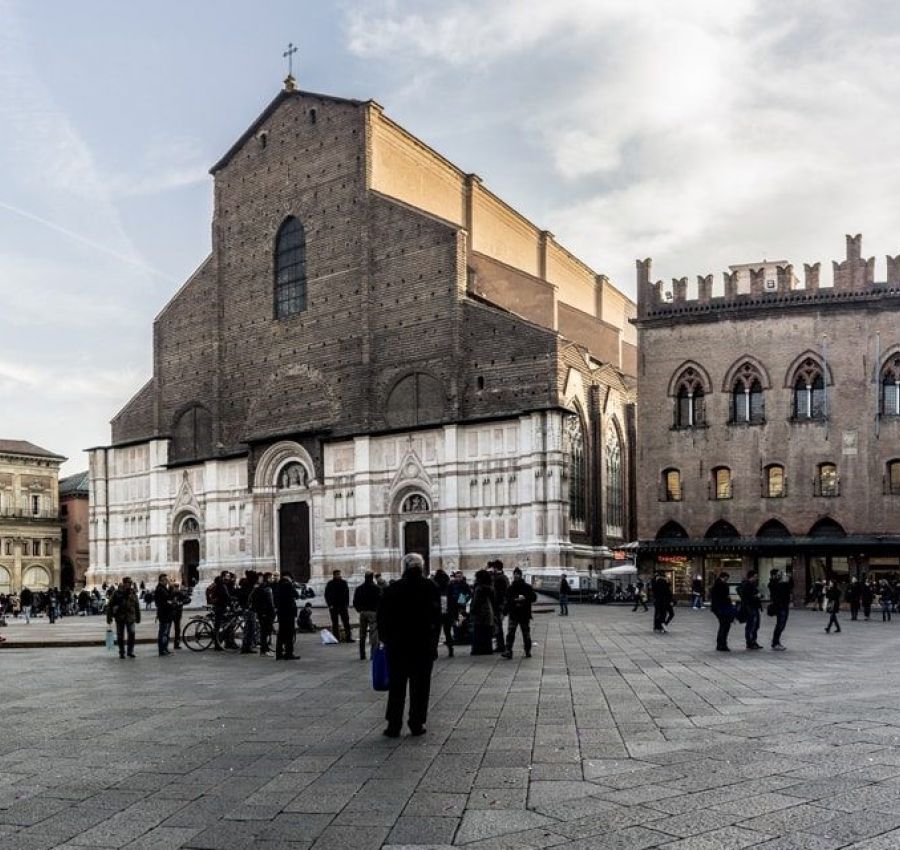
Piazza Maggiore
Piazza Maggiore is the beating heart of the city. Bounded by the four most important buildings of Bologna, this square is famous for its typical "crescentone" that raises it by one step above the ground. The square is dominated by the basilica of San Petronio which is located in front of Palazzo Re Enzo, the golden prison of the King of Sardinia. Beside these two buildings there is Palazzo dei Banchi, a spectacular building that divides the square from the narrow streets of the market of the quadrilateral and the most famous portico of the historic center of Bologna, the Pavaglione. Finally, the perimeter of Piazza Maggiore ends with Palazzo d’Accursio, also known as Palazzo Comunale, the town's municipality. This building then extends to the adjacent square that houses the Fountain of Neptune, a historic city symbol that indicates the ancient aquatic nature of Bologna. During the summer months, there will be a mega screen projection of Italian and foreign films in original language and of World Cup and European football matches.
Via Indipendenza, Via Rizzoli, Via Ugo Bassi
These three are the main commercial streets of Bologna. The T formed by the intersection of the three streets, which becomes pedestrian over the weekend, hosts bars but above all many shops. By walking in the historic center it will be almost impossible not to run into these streets that connect Piazza Maggiore, the two towers and the central train station. In these streets you can find shops such as Nike, Zara, Apple, Duglas, Desigual, Maison du Monde, HM and many others so, if you are in Bologna also to do some shopping, we strongly advise you to take a walk along the T.
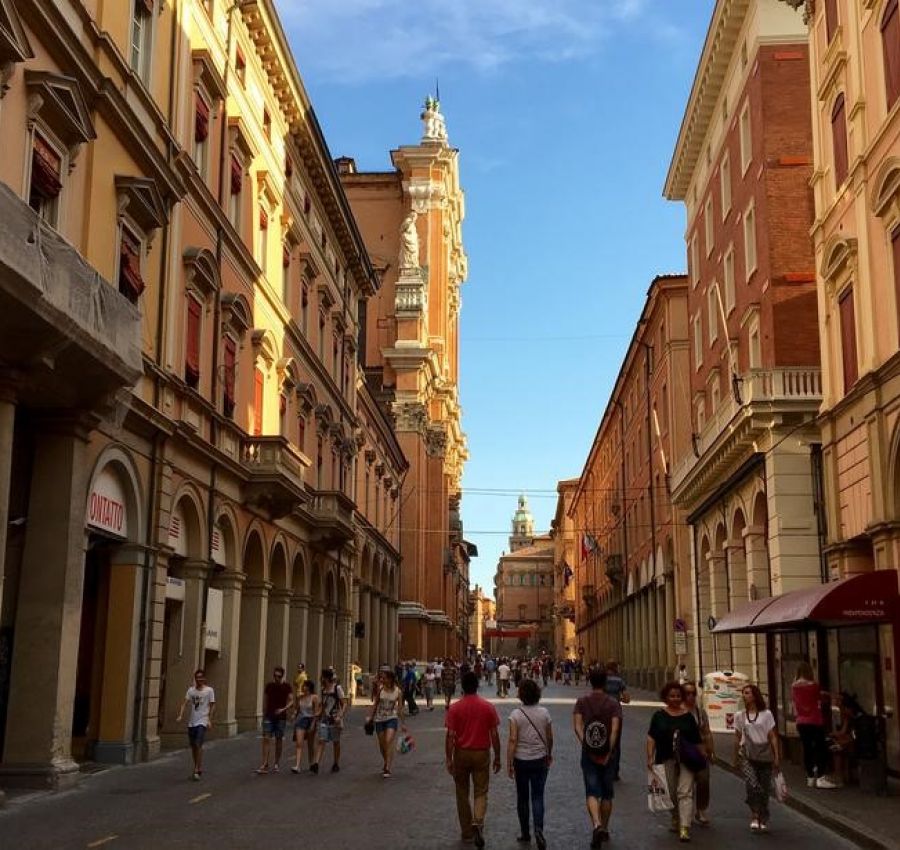

Via Farini
Via Farini is one of the main streets of Bologna. More central extension of the equally important Via Santo Stefano, Via Farini extends from Via Castiglione to Via d’Azeglio, touching Piazza Minghetti, Piazza Cavour and Piazza Galvani, three historic squares in the center of Bologna. In addition to the pedestrian T, Via Farini is also a commercial street and also hosts COS, Hermes, Furla, Falconieri and Manila Grace, and many other shops. Opposite Piazza Cavour, where one of the best ice cream parlors in Italy is located, there is a gallery dedicated to luxury, Galleria Cavour. Here reside stores such as Gucci, Luis Vuitton, Tiffany, Miu Miu, Church’s, Armani and many others. If you're in the mood for crazy shopping or maybe just a cup of coffee in one of the adjacent squares, this is the area for you.
Il Quadrilatero and the Mercato di Mezzo
The Quadrilatero is an intertwining of alleys and streets that are located between Piazza Maggiore and the Two Towers. Here there are a myriad of shops and markets selling typical Bolognese and Emilian products such as tortellini, tagliatelle, mortadella and lasagna. The main roads that form this network are Via Clavature, Via degli Orefici and Via Pescherie Vecchie which, in addition to markets and shops, is home to many bars and restaurants that also offer typical products of the region such as tigelle and crescentine for a good and quick meal. In this labyrinth of gastronomy stands the Mercato di Mezzo, a covered market in which there are many restaurant stands for all tastes.


University District
Bologna is famous for its university all over the world as it is the oldest in Europe and the second oldest in the World. Many Italian and foreign students come to study and live in Bologna and in the evening they pour into the streets to meet and eat or have a drink. The university street par excellence is Via Zamboni, the road that leads from the Due Torri to Piazza Verdi, home of the splendid Municipal Theater. These places, including Via Belle Arti and Via Righi on one side and Piazza Aldrovandi on the other, are dotted with bars, pubs and restaurants as animated as the streets that host them. This area of the city almost never seems to sleep, especially on weekends when it is very crowded with young people.
In addition to being a very beautiful area with faculties that we recommend to visit like the jurisprudence building in Via Zamboni 22, this area is also one of the most lively, especially in the evening. Recommended for young people who want to have fun until late rather than for quiet night walks.
San Petronio
San Petronio is the main church of Bologna, located in Piazza Maggiore. The church stands with its characteristic unfinished facade on the main square of the city center.
The basilica was dedicated by the Council of the Municipality of Bologna to the patron saint of the city, Bishop Petronius, who lived in the fifth century.
Bologna in the 14th century was one of the most populated and wealthy cities in all of Europe, thanks to the artisan and mercantile bourgeoisie that developed in the city that ruled the city. Already in 1307 it was decided to build a religious building of a certain importance dedicated to the saint even if due to various political vicissitudes the work began only in 1390, spurred on by the competition with the nearby Florence and Milan that had already started the construction of the respective Saints Maria del Fiore and the Duomo.
The decision to build the basilica is a unique example of a position taken by the citizens, in fact the ecclesiastics were not even questioned, on the contrary, they were very upset because they were hit particularly hard by the taxes needed for construction of the basilica.
In 1390 the master Antonio di Vincenzo was the person in charge of the construction of the work which, according to the projects that were then lost, had to exceed the size of St. Peter's in the Vatican, with a length of 180 meters. Unfortunately, partly due to the architect's untimely death after ten years of work and partly because of the future antipope Baldassarre Cossa, which was in contrast with the Municipality and contrary to the construction of the basilica, the project was not completed. The Pontifical Legate sold all the building materials taking advantage of the death of the master and in doing so blocked the works. The sculptor Jacopo della Quercia was called to decorate the entrance door but a few years later he too died. The works proceeded in fits and starts for over a century until the completion of the central nave up to the fifth span.
The Church gave Michelangelo the task of making a large bronze statue of Giuliano della Rovere (Pope Julius II) to be placed in front of the facade but this was destroyed by the lords of the city, at war with the papacy for the control of Bologna.
In 1507 the architect Arriguzzi was commissioned to continue the work and he built a huge dome with four bell towers, ending the large apse with 12 radial chapels ending the side facades of the Latin cross. The project should have extended the basilica further up to 225 meters, making it the largest religious building in the world. Today it seems difficult to think that a city like Bologna could hold a building of such great importance but at the time it was one of the most important cities in Europe, also thanks to the university which was the best in the world.
Pope Pius IV, by a political move, decided to give precedence to the construction of the adjacent Archiginnasio and other surrounding buildings which prevented the construction of the enormous work, leaving it as unfinished as we see it today.
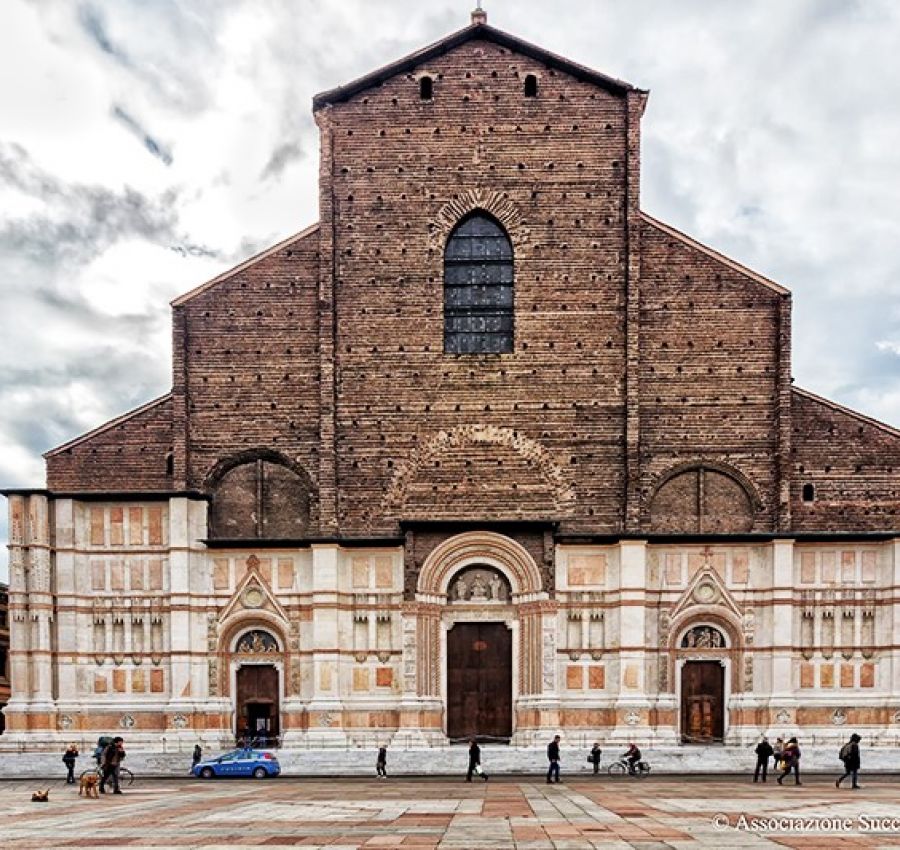



Archiginnasio
The Palazzo dell'Archiginnasio in Bologna, now home to the municipal library, was built in 1563 in record time with the aim of giving a unitary seat for all the different disciplines of the Studium (ancient name of the University), which were housed in this place for 3 centuries. The building is developed on two floors with a central courtyard surrounded by a double row of loggias. The entire palace is decorated with an infinity of noble crests that belonged to all the students and professors who were part of the Studium of Bologna. This fascinating ornamental motif is the largest mural heraldic complex in the world and arouses the admiration and wonder of visitors.
Noteworthy is the anatomical theater, an amphitheater hall entirely made of wood and decorated with statues of famous doctors of history which was used for anatomy lessons.
The Two Towers
Bologna was famous not only for the university, but also for the very high number of towers that stood on the city. There were up to a hundred towers throughout the historic center, the highest ones were a tool of offense / defense for the wealthiest families during the investiture period as well as a manifestation of power, but there were also smaller houses / towers with only only housing purposes. Furthermore, you can still find "torresotti" at the doors of the second circle of walls. Unfortunately, many towers collapsed in the 13th century, were cut off or even demolished leaving the number of these buildings at 22 in all.
The symbol of the city of Bologna are the two towers. These 12th century buildings, both pending, measure 48 meters for the Garisenda tower and 97 meters the Asinelli tower. Both were shortened by about twenty meters due to various damages and collapses due to fires, wars and lightning.
The Garisenda is even named by Dante in the XXXI Canto of the Inferno.
Originally the two towers had wooden constructions all around and connections suspended from one to the other, so as to increase the space and simplify the viability from one tower to another.
In the course of history, the Towers had various uses, including a watchtower to control the tumultuous Mercato di Mezzo and quell any revolts in the bud or in the Second World War to guide relief efforts to the places hit during the bombing.
The Asinelli Tower is also known for the experiment of the graves by Guglielmini, who, wanting to demonstrate the rotation of the Earth, let a coin fell from the tower of which did not fall on a straight line but diverted eastward by 1.7 cm . In 1792 the results of his experiment were collected in the De Diurno Terrae Motu, which was widely distributed in the scientific panorama.
Today, while the Garisenda is not open to the public, the Asinelli Tower can be visited at a cost of € 5 per head and, by going up 498 steps, you can reach the top of the building to enjoy a breathtaking view over the whole city.
Tickets can be purchased online or at the Bologna Welcome tourist center in Piazza Maggiore.
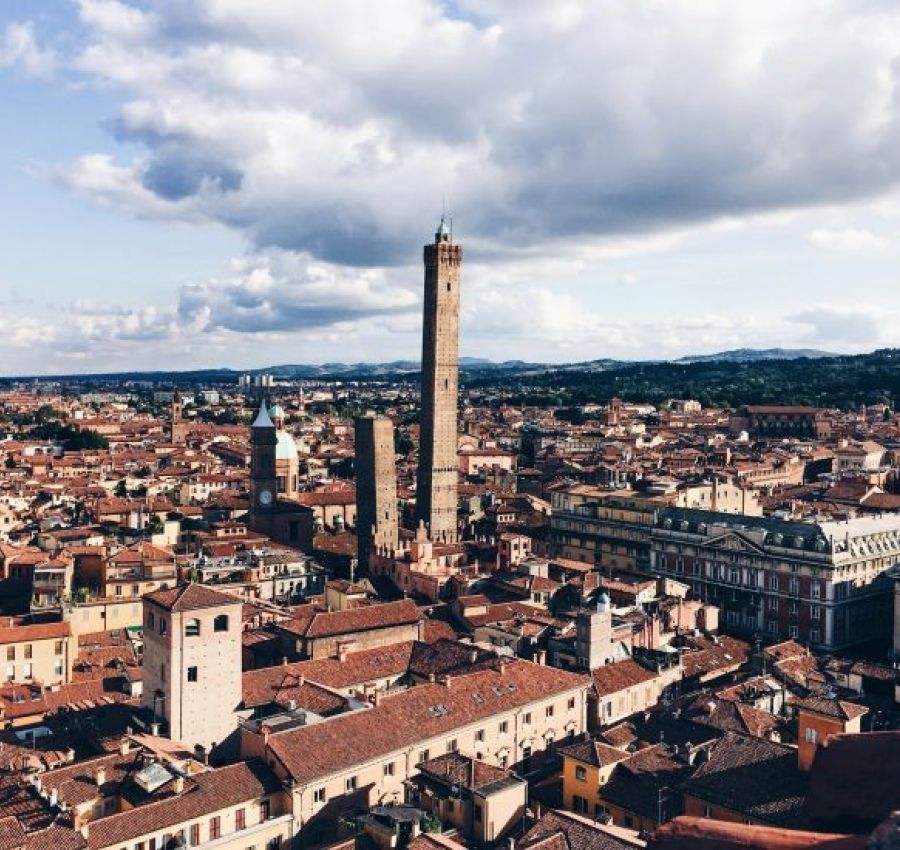

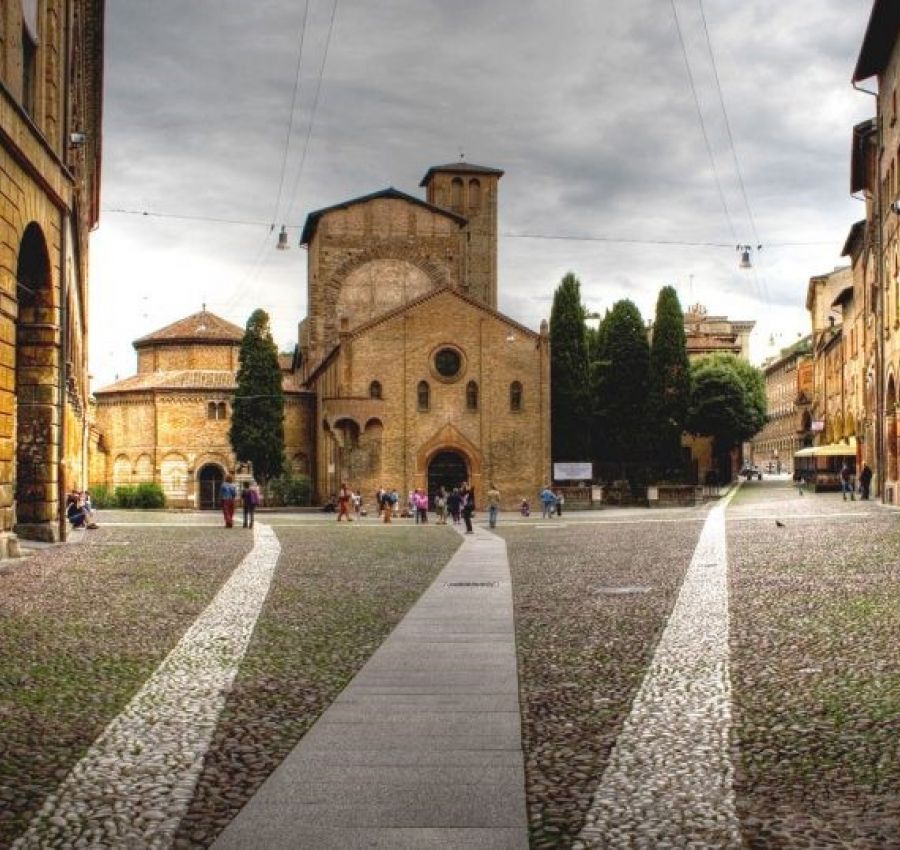


Piazza Santo Stefano
The Basilica of Santo Stefano, from which the square in front takes its name, is also known as "Sette Chiese" as it consists of several buildings joined together in a single complex.
According to the legend it was San Petronio himself, patron saint of Bologna, who designed the church, which was to be inspired by the Holy Sepulcher of Jerusalem. The building, which rises above a temple to Isis, is very old and built at different times. The oldest church is the one that takes its name and houses the sarcophagi of the martyrs Santi Vitale and Agricola which dates back to the 4th century. Subsequently, in the fifth century, the basilica of the Holy Sepulcher was built, which housed the tomb of the patron saint of the city and three centuries later the church of the Holy Crucifix, the current point of access to the basilica, was joined to the complex. During a barbarian invasion of the Hungarians in the 10th century the structure was brutally devastated and then rebuilt in the following century by the Benedictine monks who still reside there. In a later period, between 1880 and the first decades of the twentieth, a massive restoration intervention changed the face of the complex as planning was based on the Holy Sepulcher of Jerusalem, but mistakenly inspired by the reconstruction of the Crusaders rather than the original project of Constantine, now lost.
The complex consists of the Church of the Crocefisso, of Lombard origin and raised above the crypt, to the right is instead the basilica of the Sepulcher built in the fifth century by San Petronio, then bishop of Bologna, which housed the remains of the same. Tradition has it that pregnant women used to go there and, as they prayed, they made as many turns of the tomb as the years of Christ before moving to the nearby church of the Martyrium to adore the fresco of the Madonna.
Still to the right of the Holy Sepulcher is the Basilica of the Saints Protomartiri Vitale and Agricola, respectively servant and master, whose relics are kept inside the building.
Coming out of the Sepulcher we reach the Cortile di Pilato, surrounded on two sides by a portico with cruciform brick columns and with a stone basin in the center on a pedestal, known as Catino di Pilato. Under the portico, near a window, we find the statue of Gallo di San Pietro, which recalls the moment when the follower betrayed Jesus Christ. Very symbolic is the fact that the distance between the courtyard and the only raised point in the center of Bologna, San Giovanni in Monte, is the same that divides the Holy Sepulcher of Jerusalem and Mount Calvary, where Christ was crucifix.
At the end of the courtyard there is the Church of the Martyrium, which was not finished by San Petronio, it was adapted as a baptistery during the arrival of the Longobards and then rebuilt by the Benedictine monks not according to the plans of the ancient Holy Sepulcher but following those more recent reconstructions. Until 1950 there was kept a relic of the Holy Cross but even more interesting is the man-sized wooden group of the Adoration of the Magi, the oldest existing nativity scene consisting of statues in the round.
Inside the structure there is a second cloister larger than the Courtyard of Pilate. The Medieval Cloister is a portico with pre-Romanesque arches, probably dating back to the year 1000, surmounted by a splendid Romanesque colonnade two centuries later. Very special and monstrous are the capitals which would have inspired some forms of atonement of Dante's purgatory. On the walls below the arches we find tombstones engraved with the names of all the citizens from Bologna who died during the First and Second World Wars.
The square in front of the church, which bears his name, is a meeting point for locals and some university students. During the evening the whole square and the district become very lively, like Corte Isolani, a gallery that connects Piazza Santo Stefano and Strada Maggiore, which hosts many bars and restaurants.
Small Window of Via Piella
Not many people know that Bologna was originally a city of water. Before being interred between 1930 and 1950, a network of canals disentangled thanks to a system of locks starting from rivers Reno and Savena together with the Aposa stream, the only natural waterway that runs through the city. The Bolognese fleet was as powerful as the Venetian fleet and the merchants could navigate these canals from the River Port, into the current Cavaticcio, to Ferrara and Venice, towards the sea.
In addition to favoring the market, the canals brought energy to the mills which were used for the textile industry, very developed in Bologna in the 13th century, so much so as to be the biggest Italian city in this field.
Although the canals were buried, there are still some traces of the river history of Bologna, in addition to the Neptune fountain, symbol of modern Bologna, there is in fact a glimpse, a view from a small window in Via Piella that amazes visitors, bringing them for a second in another dimension, almost forgotten.
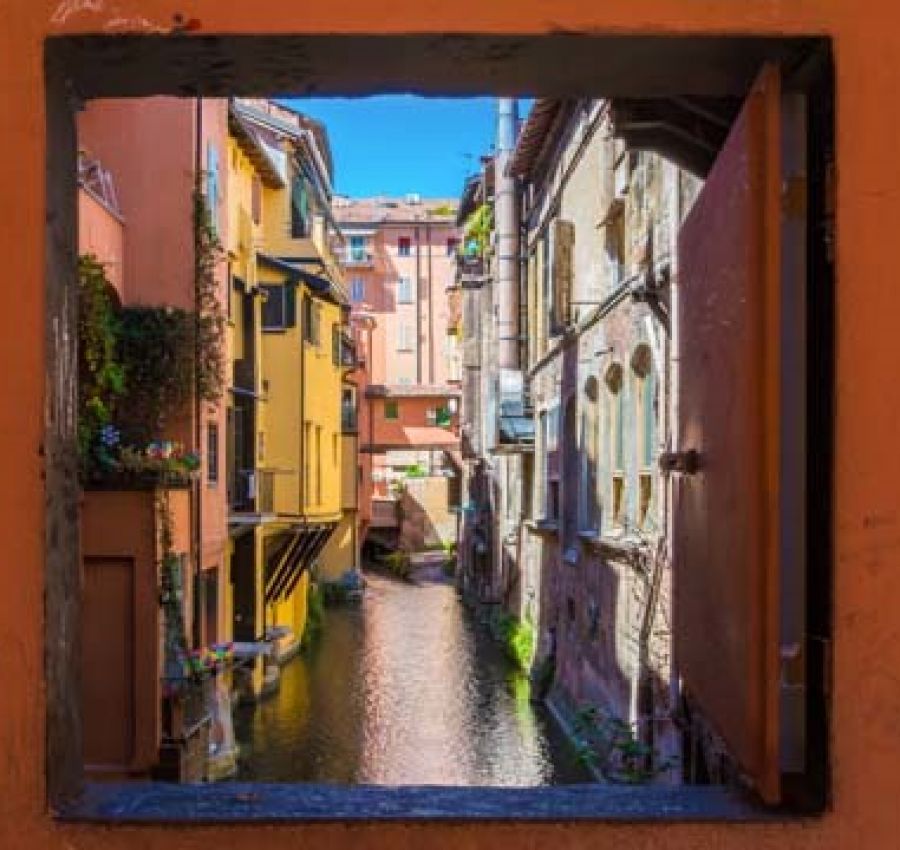

Giardini Margherita (Bologna's Public Park)
The splendid city park was built at the end of the 1800s by Count Ernesto Balbo Bertone di Sambuy, who was already an operator in the Parco del Valentino in Turin. The park was commissioned by the municipality of Bologna to transform land that had been purchased a few years before. The park was named in honor of Queen Margherita of Savoy, who had visited Bologna the previous year, thus becoming "Giardini Margherita" for everyone.
The park, which includes, in addition to the vast meadows, a lake, playgrounds and several bars, is ideal for a quiet walk or to catch some sun without departing from the center, in fact the Margherita Gardens are located close to Porta Castiglione and Porta Santo Stefano, two kilometers from Piazza Maggiore.
San Michele in Bosco
San Michele in Bosco is a 4th century monastery that housed the Olivetan convent of Bologna. The complex is located in a leafy park on a hill near the city center, above Porta San Mamolo. From there you can enjoy a breathtaking panoramic view of the entire city, it is in fact recognized as a well-known place for amorous encounters. In addition to the view from the square there is a famous window in the monumental corridor of the structure which, by opening precisely on the torre degli Asinelli (one of the two towers), it creates an optical telescope effect that gradually fades as it approaches the window.


San Luca
Tradition says that this other symbol of the city of Bologna was born from a shepherd who found a beautiful painting depicting the Virgin Mary at the top of a hill, so he took it to the cathedral of the city, St. Peter's. During the night the picture disappeared and they found him the next morning in the same spot. The citizens of Bologna interpreted this as a miracle and a divine signal that indicated to them the need to build a sanctuary to the Madonna on that hill.
Peculiar is also the history of the porticos, which with its 3.5 km is the longest in the world. The porticos protect the faithful in procession from porta Saragozza to the Sanctuary of San Luca. In 1677 the people participated in bringing the materials from the base to the top of the hill with a famous handrail. Also worth noticing is the symbolism that lies behind this architectural complex, in fact the covered path is made up of 666 arches, traditionally the number of the devil, so the portico would be a figurative representation of the snake to which the head is crushed by the Madonna, "interpreted" by the Sanctuary of San Luca.
There is a very convenient means of transportation, called San Luca Express, which allows visitors to reach the Sanctuary quickly and effortlessly. It is an ad hoc wheel train that starts from Piazza Maggiore and climbs up to the hill where the basilica is located. Tickets can be bought at the Bologna Welcome tourist center in Piazza Maggiore.
Rocchetta Mattei
This gem from the mid-nineteenth century stands on the northern Apennines in the town of Savignano. The castle was built by Count Cesare Mattei, a famous doctor who founded electroopathy, a practice based on homeopathy. The castle hosted many illustrious figures such as Louis III of Bavaria and Tsar Alexander II, who came to be visited by the Count, even quoted by Dostoevskji in the Brothers Karamazov. During the Second World War the Germans ruined the interior of the castle. Consequently the owner of the time wanted to donate the castle to the Municipality of Bologna, which refused. In 1959 it was bought by Primo Stefanelli who decided to restore it. In the early 2000s the castle has been acquired by a public banking foundation which completed the restoration and opened the castle to the public.
The fortress was born from the ruins of a castle that in the past belonged to the emperors Frederick Barbarossa and Ottone IV who used to control the passage of the Rhine valley and then ended up in ruins due to the arrival of more advanced defensive methods.
The fortress is very eclectic in style but sees the Moorish prevail with additions of medieval Italian architecture. In the Rocchetta the Loggia Carolina in oriental style, the chapel and the Sala dei Novanta are particularly noteworthy. Tickets can be bought online at the following website in Italian only or at Bologna Welcome in Piazza Maggiore.
www.rocchetta-mattei.it

Appartamenti Bologna Centro
Camere Bologna Campagna
Orari
-
Ufficio/ Prenotazioni
-
Lunedi-Domenica:
dalle 8 di mattina alle 10:00 di sera.
Contatti
Bologna's Historic Center
Bologna Countryside
Opening time
-
Booking office
-
Monday Sunday:
from 8 AM to 10 PM.
Contacts

© Biancospino srl, via G. Mazzini 4, 40138, Bologna, Italia P.Iva: IT02143131205. Tutti i diritti riservati
©2019 Biancospino srl, via G. Mazzini 4, 40138, Bologna, Italy VAT N.: IT02143131205. All rights reserved